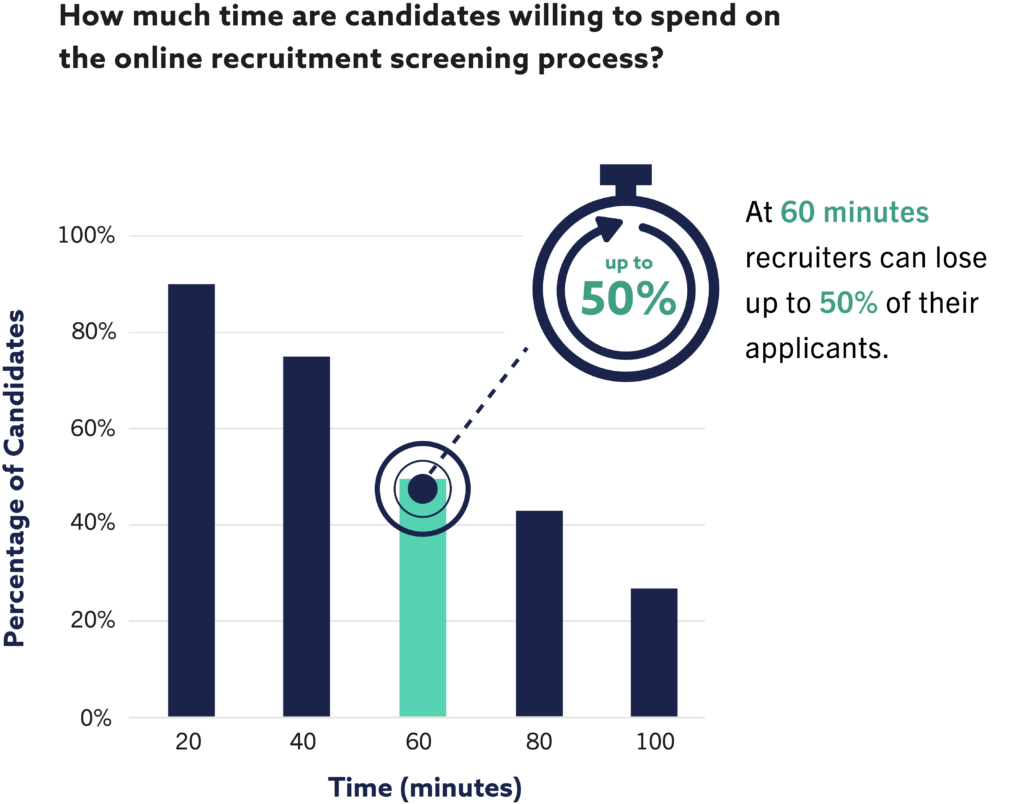Article · 5 minute read
More Haste, Less Speed: Is time-to-hire a true indicator of efficiency?
20th February 2024
One of the most common KPIs (Key Performance Indicators) talent acquisition teams are asked to report against is time-to-hire. In fact, no less than 50% of organizations currently report using this metric as a key KPI 1.
An efficient recruitment experience is a key component of a positive candidate experience. A lengthy process can prove disengaging, reflect poorly on an organization’s brand and ultimately lead to candidates dropping out of the process early or accepting offers elsewhere.
Our research suggests that, at a duration over 60 minutes, recruiters can lose up to 50% of applicants from their process.

However, when it comes to internal efficiency, can this KPI present a false economy of how well TA is performing? In a recent episode from our Deep Dive podcast series looking at the challenges of recruitment, Andrew Meechan, Head of Talent Acquisition at Third Space, shared an interesting perspective:
“In talent acquisition, in terms of KPIs and things people use to measure success, time-to-hire is probably the most widely spoken about, but I absolutely flat out refuse to have that as a measure of performance, for our team, or in our business. What’s most important to us is that we get the right person.”
Quality vs Quantity – An efficiency equation
Time-to-hire has a role to play for internal efficiency as well as candidate experience; a lengthy process can be resource intensive and costly. However, the goal for talent acquisition should be continually raising the bar in finding great people for their organization, and a focus on filling roles as quickly as possible can have a detrimental effect.
Forbes Business stress the need for a balance between speed and quality: “Time-to-hire is an important metric, but it shouldn’t always be the most important metric. In some cases, a fast hire is the most important thing. However, most companies would much prefer to prioritize quality over speed. Good recruiters make both happen, but recognize that quality always takes precedence.” 2
If talent acquisition teams are encouraged and measured against filling a role as quickly as possible, the danger is that it becomes a ‘bums-on-seats’ exercise and not a case of finding the best person for the role. In terms of efficiency, a wrong hire will underperform or leave, putting the team back at square one….but with a stellar performance metric of time to hire.
The cost of making a quick but poor hiring choice can far outweigh the cost of having the vacancy open or position unfilled for a longer period.
“With a total average cost of one bad hire at $15K, and the cost of losing a good hire (as a result of hiring the wrong person) at $30K, it stands to reason that companies have to rethink their measurement metrics and emphasize to recruiters what it would mean to be a ’good recruiter’ for the company,” says Amit Mizrahi, Head of Strategic Operations at Wix. 3
The effects of a poor hire go well beyond the financial, however. Nearly three in four employees are affected by a bad hire, according to a recent survey by Career Builder. 4
Check out our article What is the true cost of hiring a bad manager? for more on this.
“It’s important to note that there’s a ripple effect with bad hires. Disengagement is contagious — poor performers lower the bar for other workers on their teams, and their bad habits spread throughout the organization,” says Rosemary Haefner, Chief Human Resources Officer at CareerBuilder.
For time-to-hire to be a true efficiency indicator it needs to be looked at in the context of how quickly the role was filled, against the retention and performance of the hire.
Striking the balance between pace and quality
Whilst the relationship between time-to-hire and quality of hire is crucial, it doesn’t mean the dial should shift completely the other way. Organizations still need people in role and TA teams can’t be under the illusion they can take as long as they want to find the right person. So how can the balance between the two be struck?
There will never be a one-size-fits-all answer, but here are some considerations that might be useful in balancing the pace of hiring with the quality of new hires:
- Communicate with hiring managers and leaders; explain why the process exists. You are the experts.
- Ensure there is an understanding around the cost of making a bad hire and how the process is designed to mitigate this risk.
- Be clear with candidates on what the role is (and isn’t) to prevent the wrong people applying or progressing through the process.
- Understand the ‘soft skills’ that are predictive of potential for the role as well as any technical requirements so you can assess for success.
- Assess early and accurately. The breadth and depth of insight gathered from online personality questionnaires such as Wave would be impossible to glean from traditional hiring methods, equipping TA Partners and hiring managers to focus on what is most important.
Transform your Talent Acquisition Today
Our team will be happy to show you how our tools can help you improve the efficiency of your hiring process.